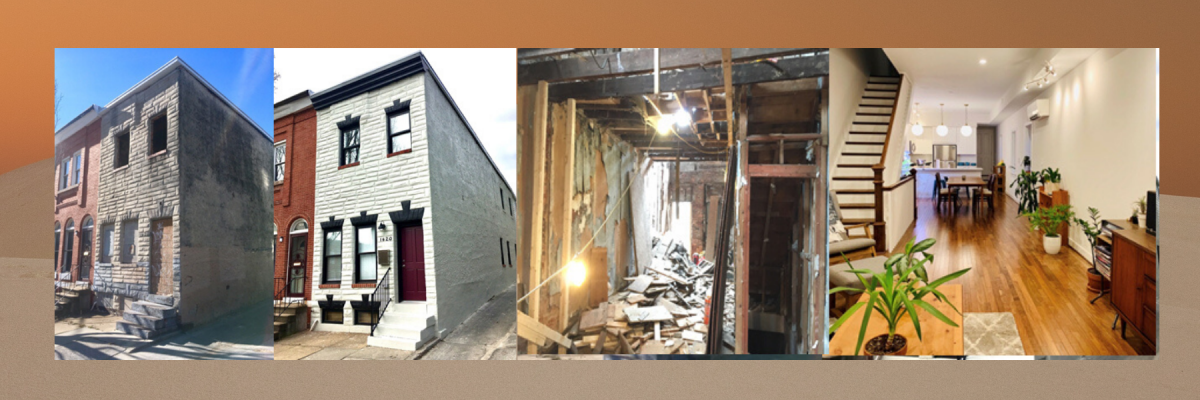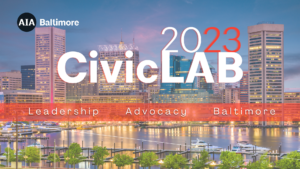Written by Tim Barranco, Project Manager, Lorax Partnerships
Baltimore City is home to more than 16,000 vacant buildings, and as daunting as this problem may seem, it is also a massive opportunity: an opportunity to preserve historic architecture, to provide affordable and equitable housing, and to create sustainable and healthy homes.
In the spring of 2018, I began planning the renovation of a historic rowhouse in the Station North neighborhood, with the goal of turning a 100-year-old vacant brick shell into a net-zero energy, LEED Platinum home. Two years later, I received my first bill from Baltimore Gas and Electric showing a negative balance. This brief case study outlines design recommendations to optimize sustainability and affordability while complying with state and local historic guidelines.
Choosing to renovate an existing rowhouse was the first big step in tackling all three goals. The renowned sustainable architect Carl Elefante, FAIA, once said, “The greenest building is the one that is already built.” Our industry is shifting more attention to embodied carbon, and building reuse is the simplest way to minimize that footprint. Beyond that, demolishing the shell for ground-up construction would have increased costs, delayed the schedule, and eliminated the opportunity for historic preservation (and historic tax incentives, which tie back to affordability).
The shell we started with was 14’ wide, 50’ deep, and two stories tall, about 1,400 square feet in total. By the time I met with the builder, architectural plans were already drawn up for a 2 bedroom, 2 bathroom layout on the upper floor, with an open-concept living room/dining room/kitchen on the ground floor and small powder room tucked in the back, and a shallow unfinished basement which provides additional storage space and a constant opportunity to bang your head. The layout made efficient use of the space and we decided to leave it as is.
- All-electric, no gas. To be truly net-zero energy, we eliminated natural gas so that all energy used can be balanced with on-site renewable electric production from solar panels. We ditched the gas furnace for a heat pump and opted for a ductless system to increase efficiency and free up space (no duct chases, smaller bulkheads). For cooking, we went with an induction range, which boils water 2x faster than gas and only added $100 to the budget.
- In addition to a heat pump for space conditioning, the water heater and clothes dryer also use heat pumps. In both instances, those appliances use about ½ the energy of traditional equipment. BG&E offers a $500 rebate on the water heater, allowing it to pay for itself in under 2 years. Fair warning for anyone looking at heat pump clothes dryers: they do need longer run times, typically 90 minutes for a full load.
- Stud walls are spaced at 24” o.c. instead of 16” to reduce embodied carbon and thermal bridging (less wood, more insulation). Studs were also held 2” off the existing masonry wall to allow for a layer of continuous insulation.
- To reduce air leakage, AeroBarrier (an aerosolized sealant) was used during a blower door test (big fan in the front door entryway pressurizing the house). The positive pressure forces air out through any leaks in the envelope and AeroBarrier follows the airflow and gums up the leaks. In just a few hours, it reduced air leakage by 94%, even exceeding Passive House airtightness standards. Unfortunately, that was before windows were installed, and it turns out the double-hung wood windows required for historic compliance leak like sieves. I’m currently working with the window manufacturer on a weather-stripping solution to tighten them up.
- For energy savings, the ideal choice would be a heavily tinted Low-E coating on the glass, and for historic compliance, the easy solution is no coating at all. The window supplier’s default option for clear glazing had abysmal performance specs, and their standard selections for Low-E coatings were too reflective; working directly with the glass manufacturer allowed us to find the most transparent Low-E coating available, which provided decent performance without sacrificing the historic aesthetic.
- We installed a central Energy Recovery Ventilator, which captures all of the exhaust from the house and uses it to pre-condition the incoming fresh air. In the winter, fresh air (cold + dry) is warmed and humidified by the outgoing exhaust. In the summer, fresh air (hot + humid) is cooled and dried by the exhaust. It saves energy, provides a more comfortable indoor environment, and allows the fresh air to be run through a filter- especially important in the city, where “fresh air” isn’t always so clean.
- Standard plumbing fixtures were swapped out for low-flow options, cutting water consumption by about 50%. The 1.5 gpm kitchen faucet and 0.5 gpm bathroom faucets from Ikea are easy to find and easy to live with. Less common are the 0.8 gpf toilets and 1.25 gpm showerheads made by Niagara. Fortunately, the toilet works just fine. The showerheads, on the other hand, are frankly miserable. Sometimes you find a line between conservation and comfort that’s not worth crossing. On the upside, they cost $10/each and take all of 2 minutes to replace.
- To keep costs down and support the “Reduce/Reuse/Recycle” philosophy, we used second-hand items to furnish the house wherever possible. A farmhouse sink and pendant lighting in the kitchen, high-efficiency ceiling fans in the bedrooms, and mid-century modern dining room furniture all came at bargain prices from Craigslist. Reclaimed wood shelving throughout the house is made from the original floor joists that were set aside during demolition.
- Other green building features include all-LED lighting, Energy Star appliances, low-VOC materials, and an indoor air quality monitor.
- Last but not least is a 7.4 kW solar panel array on the roof which generates roughly 9,000 kWh/year. Based on the energy modeling done during design and the first few months of electric bills, the house will use about 5,500 kWh/year*, leaving 3,500 kWh for electric vehicle charging (around 10,000 miles).
*For the energy nerds, that’s an EUI of 13.4 kbtu/sf/yr, about 50% less than code-minimum construction
Regarding affordability, there is no doubt this house costs more to build than standard construction. The goal for affordability was instead based on the total monthly cost of ownership. In that sense, the decrease in utility bills is at least as much as the increase in mortgage payments. And while the net result is saving just a few dollars each month, everything goes toward ownership of the home, not to utility bills. It also makes monthly expenses more consistent and easier to budget, without the worry of a sky-high heating bill on a cold winter month. Beyond the energy cost analysis, the historic preservation programs provided significant financial assistance: a 20% refund on qualifying construction costs, and a 10-year freeze on property taxes at pre-construction levels. The City also offers a $10,000 “vacant-to-value” credit to assist with closing costs, encouraging the renovation of abandoned properties. Combined with, these programs make it possible to bring new life to Baltimore’s vacant buildings, preserving their rich architectural history while creating sustainable, affordable housing for all residents.


